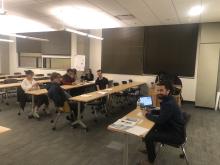On Friday December 2, Professor Adam Benkato of U.C. Berkeley provided MELC students and members of Seattle's Iranian community with a unique opportunity to learn about the Middle Persian language. In his interactive workshop, Dr. Benkato gave a brief, public-oriented introduction and overview of Middle Persian and its sources. In use roughly over the course of the 1st millennium CE, Middle Persian (pārsīg)—the ancestor of what we know today as New Persian (fārsī)—was the main language of the Sasanian empire's public monuments and administration, the vehicle of classical Zoroastrian literature, and one of the primary languages of Manichaeism.
The participants learned about how Middle Persian grammar works and how it deploys Aramaic words in its writing system (a phenomenon known in Persian as hozvaresh). Using his prepared handout, Prof. Benkato helped participants read outloud excerpts of Šahrestānīhā ī Ērānšahr (ed. T. Daryaee, Costa Mesa, 2002) in Middle Persian. On December 1, Dr. Benkato had given the 2022 Afrassiabi distinguished lecture in Persian and Iranian Studies. His talked focused on the cultural geography in which middle Iranian languages --Bactrian, Middle Persian, Chorasmian, and Parthian-- operated after the advent of Islam.
The Middle Persian workshop, which was co-sponsored by the Peyvand cultural organization, was part of a broader effort to deepen connections between the University of Washington's Middle Eastern Languages and Cultures department and the Iranian community in Washington State. Students and community members who are interested in participating in more initiatives like this are welcome to reach out to Prof. Fani (ariafani@uw.edu).
